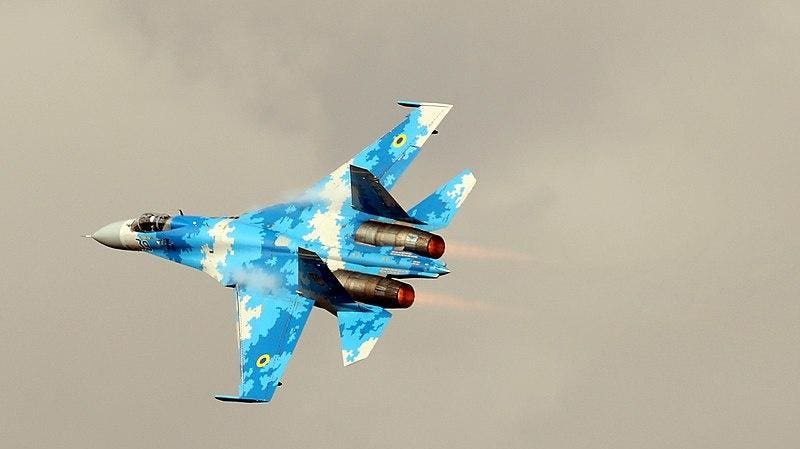The Ukrainian air force has armed its Sukhoi Su-27 Flankers with American-made Joint Direct Attack Munition-Extended Range glide-bombs, transforming the aging interceptors into multi-role fighter-bombers.
We know this because the air force wanted us to know. To celebrate Ukraine’s independence day on Thursday, the service posted a photo of Lt. Gen. Mykola Oleshchuk—the air force commander since 2021—scrawling his best wishes on a 500-pound JDAM-ER hanging on a custom-made pylon under the wing of one of the air arm’s 1980s-vintage Su-27s.
The Su-27-and-JDAM combination is a potentially powerful one. The twin-engine, single-seat Su-27 with its 36-ton maximum weight can haul tons of bombs out to a radius of 700 miles or more—and defend itself while en route.
It took some effort to transform the interceptors into fighter-bombers. Ukraine’s fleet of Su-27s includes a mix of Su-27Ss and Su-27Ps. The S-models are first-generation Flankers with only rudimentary air-to-ground capability employing unguided bombs. The Su-27Ps had their bomb interfaces removed in the late 1980s.
The Su-27s are the Ukrainian air force’s primary air-superiority fighters, but the service’s pilots maintained some air-to-ground proficiency even before the United States donated JDAM-ERs last year. This was obvious when the air force sent a flight of Su-27s to bomb the Russian garrison on Snake Island in May 2022.
The Su-27Ss already could carry bombs. And restoring the Su-27Ps’ air-to-ground capability wouldn’t have been too difficult. But to employ the GPS-guided JDAM-ERs, American and Ukrainian contractors had to invent a new pylon.
Fortunately for the Ukrainians, a lot of the conceptual work was done in advance of the first JDAM’s arrival in Ukraine last summer. When the United States supplied Ukraine with High-Speed Anti-Radiation Missiles last spring, it also supplied Ukraine with custom pylons for Su-27s and smaller Mikoyan MiG-29s.
A slightly different custom pylon—one including a Mil-Std-1760C digital data bus—should make the MiGs and Sukhois compatible with the JDAM-ER.
A fighter brigade can program target coordinates into a JDAM before a sortie. But the bomb still needs to know where it is, and how fast it’s traveling, in the instant it drops. That’s the data that passes through the Mil-Std-1760C bus.
The Su-27 should make an excellent JDAM platform. The winged JDAM-ER can glide as far as 50 miles if the launching aircraft piles on speed and steeply climbs in the moments before release. The Su-27 with its twin AL-31F engines can produce 28 tons of thrust in afterburner. More than enough to toss a JDAM-ER out to its maximum range.
It’s unclear how many Su-27s the Ukrainian air force has modified for JDAMs. Ukraine inherited 74 then-new Su-27s when the Soviet Union collapsed in 1991. Twenty-three years later, as few as 24 were in active service.
The Russian invasion of Ukraine’s Crimean Peninsula in 2014 motivated Kyiv to expand the Su-27 fleet. It’s possible as many as three dozen unflyable airframes were in storage. And by 2016, at least one analyst counted 57 Ukrainian Su-27s with confirmable “bort” numbers painted on their noses.
If all 57 were flyable, it might imply Kyiv had restored every single available airframe. The Ukrainian air force has lost at least a dozen Su-27s in the past 18 months, meaning it might have as many as 45 of the interceptors left.
It’s apparent the JDAM-armed Flankers have been busy, flying interdiction missions alongside similarly-equipped MiG-29s and cruise-missile-armed Sukhoi Su-24 bombers. As Ukrainian brigades around Robotyne, in southern Ukraine’s Zaporizhzhia Oblast, fight their way south toward Russian-occupied Melitopol, the JDAM-bombers have flown ahead of them.
The main tactic is for the fighter-bombers to strike the command posts of defending Russian regiments right before a Ukrainian ground assault. That the tactic is working is evident the Ukrainian ground forces’ slow but steady progress toward Melitopol.
However many JDAM-armed warplanes the Ukrainian air force currently has, the number is about to grow. By a lot. Denmark has pledged 19 surplus Lockheed Martin F-16s to the Ukrainian war effort. The Netherlands meanwhile is offering some or all of its own 42 surplus F-16s. And Norway will donate some F-16s, too—perhaps a dozen or more.
The Danish, Dutch and Norwegian F-16A/B MLUs already are fully compatible with the JDAM … as well as a lot of other Western-made precision munitions.
Read the full article here





